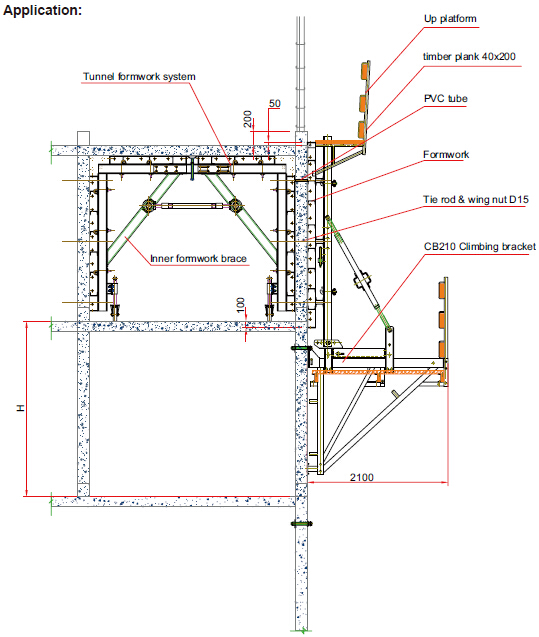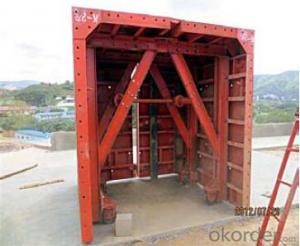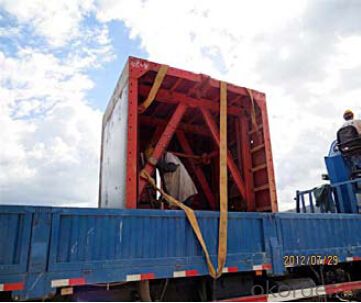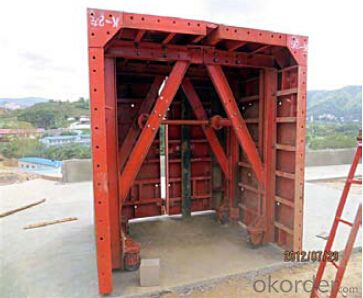Steel tunnel for formwork and scaffolding systems
- Loading Port:
- Tianjin
- Payment Terms:
- TT OR LC
- Min Order Qty:
- 50 m²
- Supply Capability:
- 1000 m²/month
OKorder Service Pledge
Quality Product, Order Online Tracking, Timely Delivery
OKorder Financial Service
Credit Rating, Credit Services, Credit Purchasing
You Might Also Like
Building Tunnel Formwork:
A compositional steel formwork system mainly used in the building which has regular structure
without beams, the excellent formwork system can make the integral pouring for the wall & slab
easily achieved.
Characteristics:
◆ High stiffness, make perfect shape for concrete.
◆ Easy operation, save labor and force.
◆ Fast forming, repeatedly turnover.

- Q: Can steel formwork be used in areas with limited access or space constraints?
- Yes, steel formwork can be used in areas with limited access or space constraints. Steel formwork is known for its high strength and durability, allowing it to withstand harsh conditions and be easily maneuvered in tight spaces. Its modular nature also enables it to be assembled and disassembled efficiently, making it suitable for use in areas with limited access or space constraints.
- Q: How is steel formwork installed?
- Steel formwork is installed by first preparing the construction site, ensuring a level surface and proper alignment. The steel panels are then assembled and secured together using bolts or clamps to create the desired form shape. Reinforcement bars and spacers are placed within the formwork to maintain the required concrete thickness. Finally, the formwork is braced and supported using props or scaffolding to ensure stability during the concrete pouring process.
- Q: How does steel formwork contribute to the overall efficiency of concrete construction?
- Steel formwork contributes to the overall efficiency of concrete construction in several ways. Firstly, steel formwork is known for its durability and strength, allowing it to withstand the pressure exerted by wet concrete during the pouring and curing process. This durability ensures that the formwork remains intact and stable, reducing the risk of collapse and ensuring the safety of workers. Secondly, steel formwork is highly versatile and can be easily customized to meet the specific requirements of a construction project. It can be easily adjusted and modified to create different shapes and sizes, allowing for the construction of complex and intricate concrete structures. This flexibility in design helps to optimize the use of concrete and minimize wastage, ultimately reducing material and labor costs. Furthermore, steel formwork is reusable, making it a cost-effective solution for multiple construction projects. Unlike other formwork materials such as wood or plastic, steel formwork can be dismantled and reused multiple times without compromising its structural integrity. This not only saves money, but also reduces the environmental impact associated with construction waste. Additionally, steel formwork offers a smooth and even surface finish to the concrete, enhancing the aesthetics of the final structure. This is particularly important for architectural projects where the appearance of the concrete is a key consideration. The use of steel formwork ensures that the concrete surface is free from imperfections, resulting in a high-quality finish. Lastly, the use of steel formwork streamlines the construction process by reducing the time required for formwork installation and removal. Steel formwork systems are designed to be easily assembled and disassembled, saving valuable time during the construction process. This increased efficiency allows for faster project completion and reduced labor costs. In conclusion, steel formwork significantly contributes to the overall efficiency of concrete construction through its durability, versatility, reusability, aesthetic enhancements, and time-saving benefits. By utilizing steel formwork, construction projects can be completed more efficiently, cost-effectively, and with higher quality results.
- Q: How does steel formwork affect the overall constructability of the structure?
- Steel formwork plays a crucial role in enhancing the overall constructability of a structure. Firstly, steel formwork offers high strength and durability, which ensures that it can withstand the pressure and forces exerted during the concrete pouring and curing process. This strength allows for the construction of taller and more complex structures, providing greater flexibility in design. Moreover, steel formwork is highly reusable, which significantly reduces construction time and costs. Unlike traditional wooden formwork, steel formwork can be easily dismantled, cleaned, and reassembled for subsequent concrete pours. This reusability eliminates the need for continuous formwork fabrication, resulting in faster construction cycles and increased productivity. Additionally, steel formwork provides excellent dimensional accuracy and stability. The rigid structure of steel formwork ensures that the concrete is poured and shaped precisely according to the desired dimensions, resulting in a more accurate and seamless end product. This accuracy is crucial in high-quality construction, especially when it comes to critical elements such as walls, columns, and beams. Furthermore, steel formwork offers superior surface finishes and better concrete quality. Its smooth and non-absorbent surface prevents leakage or seepage of water from the concrete, resulting in a higher-quality finish. This is particularly important when constructing structures that require high aesthetic appeal or when concrete surfaces need to be exposed and showcased. Lastly, steel formwork provides enhanced safety on construction sites. Its robust structure and stability reduce the risk of accidents during the concrete pouring and formwork removal processes. Steel formwork also allows for easier access and movement of workers, ensuring that they can perform their tasks safely and efficiently. In conclusion, steel formwork significantly improves the overall constructability of a structure. Its strength, reusability, dimensional accuracy, surface finish, and safety benefits make it a preferred choice for construction projects. By using steel formwork, construction processes become more efficient, cost-effective, and reliable, resulting in a higher-quality end product.
- Q: What are the different edge protection systems available for steel formwork?
- Steel formwork offers various options for edge protection systems, each devised with the intention of safeguarding construction workers and providing support. Guardrails are a common choice, typically made of steel or aluminum, which are installed along the formwork edges to prevent falls. These guardrails are easily adjustable in height and can be effortlessly installed and removed as necessary. Another edge protection system involves the use of safety nets. These nets are positioned beneath the formwork, acting as a barrier to catch any falling workers or materials. Manufactured from durable synthetic fibers, safety nets are engineered to absorb the impact of a fall, minimizing the risk of injury. Toe boards are an additional type of edge protection system. These boards are installed along the lower edge of the formwork, preventing tools, equipment, or materials from falling and causing harm. Typically crafted from wood or metal, toe boards are securely fastened to the formwork. Moreover, comprehensive edge protection solutions are available, combining guardrails, safety nets, and toe boards. These holistic systems offer multiple layers of protection to ensure worker safety at the construction site. In conclusion, the range of edge protection systems offered for steel formwork serves to prevent falls, safeguard workers, and establish a secure working environment. It is crucial for construction companies and workers to meticulously evaluate the specific requirements of their project and select the appropriate edge protection system to fulfill their needs.
- Q: How does steel formwork compare to aluminum formwork?
- Steel formwork is generally more durable and long-lasting compared to aluminum formwork. It can withstand higher pressures and is more resistant to wear and tear. Additionally, steel formwork has better load-bearing capacity and is suitable for heavy construction projects. However, aluminum formwork is lighter and easier to handle, making it more convenient for smaller-scale projects or sites with limited space. Ultimately, the choice between steel and aluminum formwork depends on the specific requirements and constraints of the construction project.
- Q: Is steel formwork suitable for all types of construction projects?
- Steel formwork is a versatile and widely used construction material that is suitable for a variety of construction projects. However, it may not be suitable for all types of construction projects. Steel formwork offers several advantages such as durability, reusability, and high load-bearing capacity. It can be used for both large-scale and small-scale projects, including residential, commercial, industrial, and infrastructure projects. Steel formwork is particularly well-suited for projects that require a high degree of precision and quality finish, such as high-rise buildings, bridges, and tunnels. However, there are certain factors to consider when determining the suitability of steel formwork for a specific construction project. One important factor is the project's budget. Steel formwork tends to have a higher initial cost compared to other types of formwork materials such as timber or aluminum. Therefore, it may not be suitable for projects with tight budget constraints. Another factor to consider is the project's timeline. Steel formwork requires skilled labor and time for assembly, disassembly, and transportation. This may result in longer construction periods, which may not be feasible for projects with strict deadlines. The complexity of the project is also an important factor to consider. Steel formwork is highly adaptable and can be custom-made for specific project requirements. However, if the project involves irregular or complex shapes, it may be more challenging and time-consuming to construct steel formwork compared to other types of formwork materials. Additionally, the environmental conditions of the construction site should be taken into account. Steel formwork is durable and can withstand harsh weather conditions. However, it may not be suitable for projects in coastal areas or locations with high humidity, as steel is susceptible to corrosion. In conclusion, while steel formwork is suitable for a wide range of construction projects, its suitability should be evaluated on a case-by-case basis. Considerations such as budget, timeline, complexity of the project, and environmental conditions should be taken into account to determine if steel formwork is the most suitable choice for a specific construction project.
- Q: Can steel formwork be used in high-temperature environments?
- No, steel formwork is not suitable for use in high-temperature environments. Steel has a high coefficient of thermal expansion, meaning it expands significantly when exposed to high temperatures. This expansion can lead to warping, distortion, and even structural failure of the formwork. Additionally, steel can lose its strength and load-bearing capacity at elevated temperatures, making it unsafe for use in high-temperature environments. It is recommended to use alternative formwork materials such as heat-resistant plastics or composite materials that are specifically designed for high-temperature applications.
- Q: How does steel formwork affect the overall labor productivity in construction?
- Labor productivity in construction can be significantly influenced by steel formwork. The durability and strength of steel formwork allow it to withstand the pressures and forces exerted during the concrete pouring process, reducing the frequency of repairs or replacements. This minimizes downtime and increases overall labor productivity. In addition, steel formwork provides a high level of accuracy and precision in creating concrete structures, resulting in better quality finishes and fewer rework or corrections. This saves time and effort for construction workers and enhances the efficiency of the construction process by achieving consistent dimensions and smooth surfaces. Moreover, the ease of assembly and dismantling of steel formwork is well-known. The modular nature of steel formwork systems allows for quick and efficient setup, reducing the time spent on formwork erection. Similarly, the ease of dismantling enables faster turnaround times between construction phases, allowing workers to move on to the next task more swiftly. Furthermore, steel formwork systems often include adjustable props, clamps, and connectors, making them highly adaptable to various construction requirements. This versatility enables workers to quickly adjust and modify the formwork to accommodate changes in design or construction plans, eliminating delays and improving labor productivity. Lastly, steel formwork contributes to a safer working environment. The robustness and stability of steel formwork systems offer enhanced protection for construction workers, reducing the risk of accidents and injuries. By ensuring worker safety, steel formwork promotes a more efficient and productive construction process. In summary, steel formwork has a positive impact on labor productivity in construction due to its durability, accuracy, ease of assembly and dismantling, adaptability, and improved safety. These factors contribute to a more efficient construction process, reducing downtime, rework, and the overall time required for project completion.
- Q: Can steel formwork be used for water retaining structures?
- Water retaining structures can indeed utilize steel formwork. One of the notable characteristics of steel formwork is its strength, durability, and ability to withstand high pressures. When designed and constructed correctly, steel formwork can establish a watertight seal and effectively resist the hydrostatic pressure exerted by water. Moreover, steel formwork facilitates a uniform and smooth finish, minimizing the chances of water leakage. However, it is crucial to implement appropriate waterproofing measures, including the use of suitable sealing materials and techniques, to prevent potential water leakage or seepage through joints or connections. Consistent inspection and maintenance are also indispensable to ensure the long-term integrity of the water retaining structure.
Send your message to us
Steel tunnel for formwork and scaffolding systems
- Loading Port:
- Tianjin
- Payment Terms:
- TT OR LC
- Min Order Qty:
- 50 m²
- Supply Capability:
- 1000 m²/month
OKorder Service Pledge
Quality Product, Order Online Tracking, Timely Delivery
OKorder Financial Service
Credit Rating, Credit Services, Credit Purchasing
Similar products
Hot products
Hot Searches
Related keywords


















